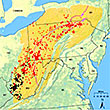Storing carbon dioxide in the same shale formations that produce natural gas may be an effective way to sequester carbon dioxide produced by fossil fuel-burning power plants, according to a U.S. study. Computer models by researchers at the University of
Virginia suggest the Marcellus Shale, a 600-square-mile formation in the northeastern U.S. that is a center of hydrofracturing natural gas, is capable of storing half the CO2 emitted by U.S. coal plants from now to 2030. Fracked shale wells are good candidates for carbon storage because CO2 can be injected in much the same way that natural gas was extracted, the researchers say. Fracking involves injecting pressurized fluids in wells to fracture the shale rock, which creates cracks that let gas seep out. The authors of this study suggest those networks of cracks could be filled with CO2 before sealing the natural gas wells.Â
Click to enlarge
U.S. Energy Info Admin
Marcellus Shale and well locations